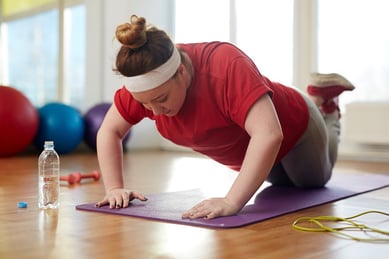The fitness craze has been booming for several years now, and it doesn’t show signs of stopping any time soon. It seems a new and improved workout routine pops up just about every other week. However, despite the promises of these new programs, rarely is one routine perfect for everyone.
Each person has his or her own individual needs, goals, and fitness levels. Instead of trying a new workout fad that may not be built for your individual goals, it’s important that those searching to improve their fitness to find a routine they can maintain and that helps them meet their personal needs.
What is Functional Fitness?
Functional fitness originated in the rehabilitation field and was designed to improve movement disorders to create functional independence. Functional fitness exercises help people prepare for life by mimicking everyday activities and engaging multiple muscle groups. They simulate common movements people do at work, home, or in sports. With functional fitness, muscles are trained to work more efficiently and reduce risk of injury.

Recently, functional fitness programs have expanded out of the rehabilitation field and have become an effective form of exercise for those seeking to improve their health and fitness. Functional fitness programs are better preparing individuals for the daily tasks they must complete in their everyday lives and in their work.
For Industrial Athletes, who perform highly repetitive and strenuous work for a living, functional fitness exercises have shown to significantly improve work performance and lower daily discomfort. Whether working on a high wire line, climbing a wind turbine or working in a warehouse, functional fitness has shown to improve balance among your bodily systems to decrease the overall risk of injury while working.
What Does Functional Fitness Look Like?
Functional fitness exercises should involve balance, strength, cardiovascular and different planar motion components. Components of a functional fitness program should include:
- Exercises based on tasks of everyday life activities
- Individualization
- Integrated or variety of exercises
- Progressive
- Repeated frequently
- Use of real-life object manipulation
- Performed in a context-specific environment
- Feedback offered
Benefits of Functional Fitness
Functional fitness programs help individuals live a better life by improving:
Posture – Functional fitness exercises improve postural muscles and improve mobility/flexibility. This improve postured allows people to sit more upright and stand tall to relieve stress on back/shoulder/neck muscles.

Cardiovascular and Muscular Endurance – Functional fitness exercises decrease the risk of chronic diseases, help maintain a healthy weight, and improve heart and lung health.
Strength – Functional fitness exercises require all muscles of the body to begin working together which reduces stress and strain on muscle groups.
Stability – Functional fitness exercises improve core strength and balance which help decrease the risk of falling. This is especially important as people age and strength and balance decline.
If you have been trying various quick fix exercise programs without getting the results you are looking for, then it is time to start a functional fitness program. These programs can be designed specifically for your needs, leading to long-term success and improvement in your overall quality of life.
About the Author
Kyle Johnson is an Industrial Sports Medicine Professional for Briotix Health, based out of the Springfield, IL area. He is a Board-Certified Athletic Trainer with a Bachelor’s in Athletic Training from Illinois State University and a Master’s in Exercise Physiology from the University of Alabama-Birmingham. Prior to joining the Industrial Sports Medicine field, Kyle worked with high school, collegiate and professional athletes. He has 4 years of experience in Industrial Sports Medicine setting.